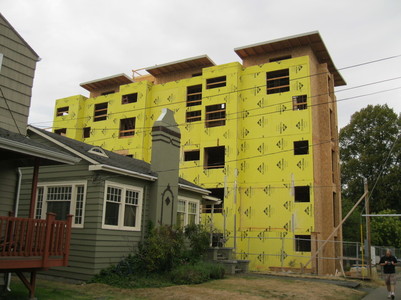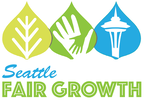
updated 4.30.17
HALA Multifamily Zoning Changes
What we know:
Ryan DiRaimo, a community land use activist and employed in the architecture field, has delved deeply into HALA MHA zoning changes. He shares his assessment of Lowrise zone changes (LR1 specifically) with us:
As they are now:
As they are proposed:
As they are now:
As they are proposed:
The example they show for LR1 is still valid, but not likely to be the most common development. Under current LR1 zoning townhomes make more development sense because you get 1 unit per 1,600 sq ft over apartments which get 1 unit per 2,000 sq ft.
Under MHA LR1 (upzoned) the 1 unit per 2,000 sq ft requirement goes away for apartments so there is no maximum number. A basic 5,000 sq ft lot with planned corridor space & circulation and fits 3 levels and 18 units under MHA LR1. That means instead of building a few town homes they can build a 20+ unit apartment building.
Ryan poses the question - why would someone build 3 townhomes when they can build an 18 unit microhousing project? 3 townhomes = ~2M in sale. 18 units X $900 / month = ~$195,000 a year.
HALA Multifamily Zoning Changes
What we know:
- Development standards are being expanded and re-defined for each zone. If your zone doesn't change in name - it will in what can be built.
- Some areas are being upzoned and Urban Village boundaries expanded.
- Single Family outside of urban villages won't be changing but there is a move to densify through expanded regulatory “opportunities” - I.e. Detached and Accessory dwelling units (backyard cottages and mother-in-law apartments). These can be good if requirements aren't loosened to allow off-site investors to buy up a swath of homes, and possibly subdivide the properties to boot.
- According to Senior City Planner Geoff Wentlandt the remaining portions of the U District outside the recent upzone area will be affected by citywide changes to the zoning standards noted above, but their zoning designations will not change.
Ryan DiRaimo, a community land use activist and employed in the architecture field, has delved deeply into HALA MHA zoning changes. He shares his assessment of Lowrise zone changes (LR1 specifically) with us:
As they are now:
- RSL 30' high, 1 unit per 2,500 sq ft, apartments not allowed
- LR1 30' high, with density limits on apartments
- LR2 30' high with no density limit on apartments
- LR3 40' high with no density limit on apartments
As they are proposed:
- RSL 30' high, 1 unit per 2,000 sq ft
- LR1 30' high, no density limit on apartments
- LR2 40' high, no density limit on apartments
- LR3 50' high, no density limit on apartments
As they are now:
- LR1 townhomes are incentivized because limit is 1 unit per 1,600 sq ft vs. apartments (1 unit per 2,000 sq ft.).
As they are proposed:
- LR1 townhomes are dis-incentivized because limit is 1 unit per 1,600 sq ft vs. apartments (unlimited).
- A 5,000 sq ft lot with a corridor space & circulation could fit 18 apartments (on 3 levels) or 3 townhomes.
- 3 townhomes = ~$2million in sale.
- 18 apartments = $TBD million in sale of the building.
- 18 apartments @ $900 / month = ~$200,000 per year in income for a building operator, so if the investment was $2M, and operating costs were neglected. This would be a 10% return on investment.
The example they show for LR1 is still valid, but not likely to be the most common development. Under current LR1 zoning townhomes make more development sense because you get 1 unit per 1,600 sq ft over apartments which get 1 unit per 2,000 sq ft.
Under MHA LR1 (upzoned) the 1 unit per 2,000 sq ft requirement goes away for apartments so there is no maximum number. A basic 5,000 sq ft lot with planned corridor space & circulation and fits 3 levels and 18 units under MHA LR1. That means instead of building a few town homes they can build a 20+ unit apartment building.
Ryan poses the question - why would someone build 3 townhomes when they can build an 18 unit microhousing project? 3 townhomes = ~2M in sale. 18 units X $900 / month = ~$195,000 a year.
